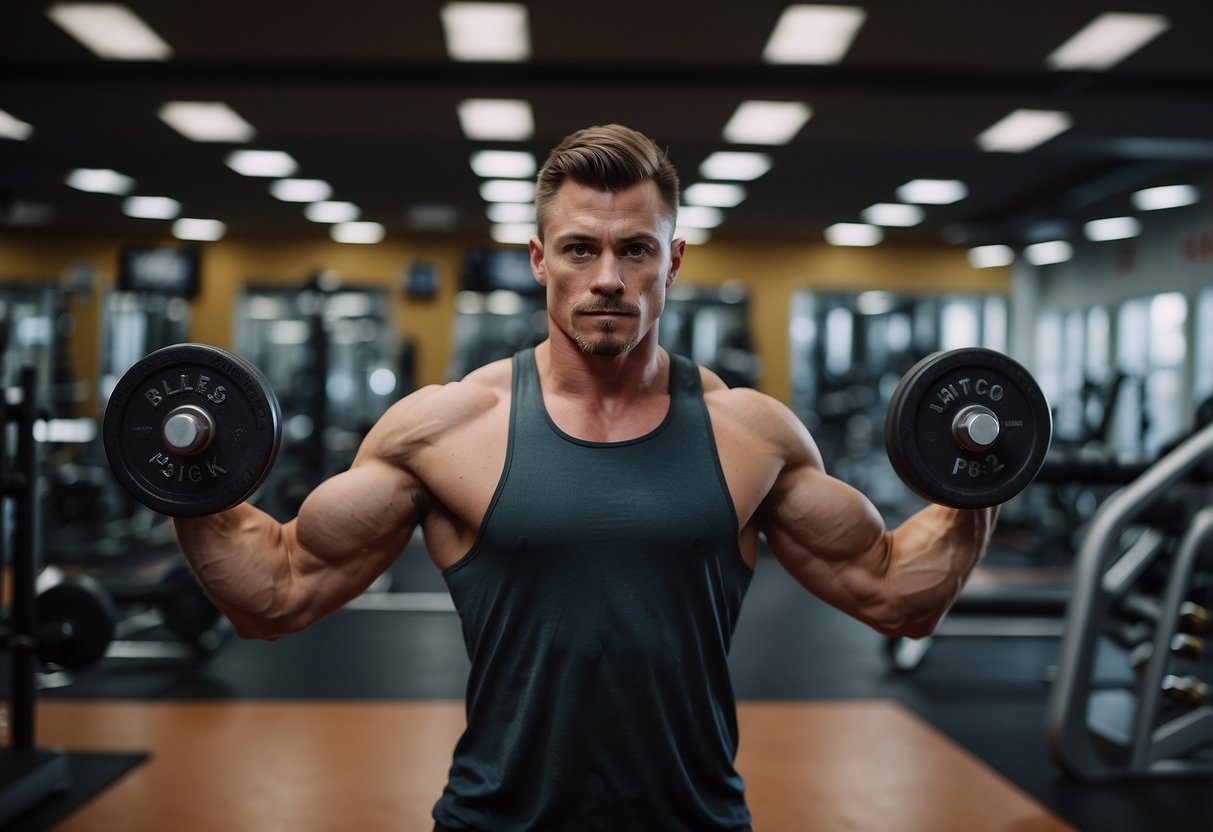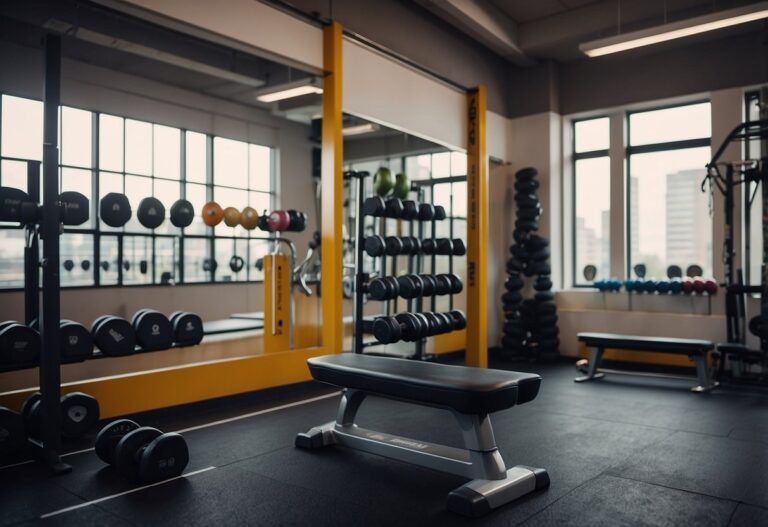If you’re looking to build stronger and bigger arms, you’re in the right place. Working on your arm muscles not only enhances your physical appearance but also improves your overall strength and functional fitness. Whether you’re a beginner or a seasoned gym-goer, having a solid plan and understanding the basics is crucial.

When it comes to arm workouts, there are various exercises that can target your biceps, triceps, and forearms efficiently. Making small adjustments to your routine can lead to significant improvements over time. Consistency and proper form are key factors in achieving your fitness goals. Taking the time to learn and apply these tips can make a notable difference in your progress.
Progressive Overload
Progressive overload is a key technique for building muscle. It involves making your workouts more challenging over time.
You might lift heavier weights, do more reps, or change your tempo. This keeps your muscles working hard and helps them grow stronger.
For example, if you usually do three sets of ten bicep curls, try adding weight or increasing your reps each week.
This method works well for other exercises too, like push-ups and bench presses. By constantly challenging your muscles, you can avoid a plateau and continue making progress.
Remember to increase difficulty gradually to avoid injury and ensure steady progress.
Compound Movements
Compound movements are a great way to build strength and muscle in your arms. These exercises target multiple muscle groups at once.
Pull-ups and chin-ups are effective for your biceps and back. They can be done using a pull-up bar in the gym or even at home.
The close-grip bench press works your triceps while engaging your chest and shoulders. Keep your hands closer together on the bar.
Standing Arnold press targets your shoulders, triceps, and biceps. It’s a great way to incorporate a full range of motion.
Using compound movements in your routine helps you get more done in less time, making your workouts more efficient.
Tricep Dips
Tricep dips are a fantastic way to strengthen your arms.
To get started, you don’t need fancy equipment. Just grab a sturdy chair or bench. Sit on the edge with your hands gripping the edge. Slide your body forward so your behind clears the chair.
Lower your body by bending your elbows. Aim for a 45-degree angle. Then push yourself back up. Repeat this for a few sets.
Don’t forget to keep your elbows tucked in. This keeps the focus on your triceps. If you want more of a challenge, try placing your feet on another chair or a bench.
Always remember to warm up before doing tricep dips to avoid injury. Light stretches or a quick aerobic activity can prepare your muscles. If done correctly, tricep dips can help you achieve stronger and more defined arms.
Bicep Curls
Bicep curls are a great way to build strength in your arms. When done correctly, they work your biceps and the muscles in your lower arm. Making sure your form is right is key to getting the most out of this exercise.
Start by standing with your feet shoulder-width apart and holding a dumbbell in each hand. Keep your elbows close to your torso and your palms facing forward. When you curl the dumbbells up, breathe out. Avoid using your back to lift the weights.
You can try different bicep curl variations to keep your workouts interesting. Changing your grip or using different equipment can help target your muscles differently. For example, you can use a barbell or resistance bands.
If you’re new to weight lifting, try starting with lighter weights and gradually increasing as your strength builds. This helps prevent injury and allows you to focus on proper form. Always remember to engage your core muscles during the exercise to stay stable.
Adding bicep curls can be the missing piece to your arm workout routine, especially if you mainly do exercises like pull-ups and rows. This move specifically targets the biceps, adding variety and effectiveness to your regimen.
Practicing bicep curls regularly will help you see improvements in your arm strength and size. Remember, consistency is key, and proper form will make a big difference in your progress.
Hammer Curls
Hammer curls are a fantastic way to build your biceps and forearms. To start, stand with your feet shoulder-width apart. Hold a pair of dumbbells with a neutral grip, meaning your palms face your torso. This grip helps target different muscles compared to regular curls.
When performing the curl, keep your elbows close to your body and curl the weights up towards your shoulders without rotating your wrists. This makes sure you engage your biceps and forearms effectively. Make sure to keep your back straight and your core engaged.
For variety, you can try alternating hammer curls, where you lift one arm at a time. This can help you focus on form and reduce the risk of injury. Plus, it’s great for building balanced strength.
By sticking to proper form and incorporating hammer curls into your routine, you can see noticeable gains in arm strength and size. It’s a simple move with big benefits.
Diamond Push-Ups
Diamond push-ups are excellent for targeting your triceps. To start, place your hands close together so your thumbs and index fingers form a diamond shape.
Begin in a plank position. Ensure your body forms a straight line from your head to your heels. As you lower yourself, keep your elbows close to your body to engage your triceps more effectively.
Avoid fully locking out your elbows. This can reduce the strain on your joints and make the exercise more comfortable. Also, keep your shoulder blades stable to support your torso properly when pushing yourself back up.
You can include diamond push-ups in your upper body workout or combine them with other tricep exercises for a killer superset. For more detailed instructions, check out Barbend’s guide.
Tricep Extensions

Tricep extensions are a fantastic exercise to strengthen and tone the back of your arms. Whether you’re using dumbbells, barbells, or resistance bands, this move isolates your triceps effectively.
To start, stand with your feet shoulder-width apart. Hold a weight in both hands and raise it above your head. Keep your elbows close to your ears. Slowly lower the weight behind your head, then push it back up.
Maintaining proper form is crucial. Avoid letting your elbows flare out. This ensures you’re targeting the right muscles and reduces the risk of injury. Think about your posture too.
If you’re a beginner, start with lighter weights. Focus on perfecting your form before increasing the weight. This helps to prevent strain and allows your muscles to build strength gradually.
Consider trying variations like overhead extensions or using a cable machine. These offer different benefits and can keep your workouts interesting.
Plank to Push-Up
The plank to push-up exercise is excellent for building upper body and core strength. Start in a plank position with your elbows under your shoulders, keeping your body straight.
Push up with your right hand first, then your left, lifting yourself into a push-up position. Lower back down to the plank by placing your elbows back down, starting with the right.
Repeat the movement, alternating the hand that pushes up first. This exercise works your biceps, triceps, shoulders, and abs.
For more detailed instructions, check out this complete guide with video.
Chin-Ups
Chin-ups are a fantastic exercise for building strength in your arms and back. They primarily target your biceps and lats.
Start with the basics. Use an underhand grip, keeping your palms facing you. Your hands should be about shoulder-width apart. Find a sturdy bar that can support your weight.
Hang onto the bar, keeping your body rigid. Squeeze your lats, core, and glutes. This will help you maintain proper form and avoid swinging.
When you are ready, pull your chin up towards the bar by driving your elbows down and back. Focus on squeezing your shoulder blades together.
If you are a beginner, try hanging from the bar for just a few seconds. Gradually increase the duration as you get stronger. To improve, consider doing multiple sets with low reps.
For variety, change your grip every few months. You can switch between underhand, overhand, and neutral grips to keep your joints healthy. Aim to include chin-ups in your routine to see noticeable improvements in your arm strength and physique.
Reverse Curls
Reverse curls are a great way to build strong and balanced arms. By holding the barbell with an overhand grip, you target muscles like the brachioradialis and the brachialis. These muscles add shape to your forearms and support overall arm strength.
Stand with your feet shoulder-width apart and keep a slight bend in your knees. Grip the barbell with your thumbs on top. This false grip increases the exercise’s difficulty and effectiveness.
Keep your upper arms close to your body and curl the weight up slowly. Avoid using momentum to maintain proper form and prevent injury. These simple tips will help you get the most out of your reverse curls.
Fundamentals Of Arm Training
When it comes to arm training, mastering the basics can make a significant difference. Focus on proper form and avoid common mistakes to maximise your results and reduce the risk of injury.
Importance Of Proper Form
Using the right form during your arm workouts is crucial. Proper form ensures that your muscles are effectively targeted, leading to better growth and strength. For instance, when performing a bicep curl, keep your elbows tucked in and your movements controlled. This helps isolate the biceps and prevents strain on other muscles.
Sloppy form can lead to injuries and diminished results. Always start with lighter weights to perfect your technique before progressing. Remember, it’s not about how much you can lift but lifting correctly to maximise muscle engagement. Paying attention to form not only enhances your performance but also helps in building a solid foundation for more advanced exercises in the future.
Common Mistakes To Avoid
Avoiding common mistakes can keep you on track for achieving your fitness goals. One frequent error is using too much weight too soon. This can lead to poor form and potentially cause injuries. Instead, gradually increase the weight as you become stronger and more comfortable with the exercises.
Another mistake is not fully extending or contracting your muscles. For example, during a tricep extension, ensure you extend your arm completely to engage the muscle fully. Half-hearted reps don’t provide the full benefit of the movement.
Also, avoid neglecting different parts of your arms. To build balanced strength, include exercises targeting both the biceps and triceps. Ensuring you have a comprehensive routine can make your workouts more effective and contribute to better overall arm development.
Maximising Strength And Hypertrophy
Maximising your arm strength and muscle growth requires a blend of strategic exercises and techniques. This includes using progressive overload and integrating resistance bands effectively into your workouts.
Progressive Overload Techniques
To build stronger and bigger arms, you need to focus on progressive overload. This means gradually increasing the weight, reps, or intensity of your exercises. Start by choosing a weight that challenges you but allows you to complete your sets with good form.
Increase Weight Gradually: Aim to add small amounts of weight each week. Even a 1.25 kg increase can make a significant difference over time.
Adjust Reps and Sets: If adding weight isn’t an option, try increasing the number of reps or sets. For example, if you’re comfortable doing 10 reps of barbell curls, try aiming for 12.
Change Exercise Variants: Switch up the types of curls or tricep exercises you do. Different angles and grips can stimulate muscle growth in new ways.
Rest and Recovery: Don’t forget the importance of rest. Muscles need time to repair and grow stronger. Allow at least 48 hours between heavy arm sessions.
You can track your progress using a workout journal or an app. This helps keep you accountable and ensures you’re consistently challenging yourself.
Effectively Using Resistance Bands
Resistance bands are versatile and can help you maximise arm hypertrophy and strength without needing heavy weights. They are perfect for adding variety to your workout and targeting muscles in different ways.
Portable and Versatile: You can take resistance bands anywhere, making them great for travel. Use them for exercises like bicep curls or tricep extensions to enhance muscle engagement.
Adjustable Resistance Levels: Bands come in various resistance levels. Start with a lighter band and then move to a heavier one as you get stronger. This simulates the concept of progressive overload.
Combine with Weights: For even more intensity, use bands alongside free weights. This combination can add extra resistance at the top of your lift, where it’s usually easier, thus making your muscles work harder.
Stabilisation and Control: Using bands forces you to stabilise your movements, engaging more muscle fibres, which can enhance muscle growth.
Warm-Up and Cool-Down: Bands are also excellent for warming up your muscles before weightlifting or cooling down afterward. This prepares your muscles for heavy lifting and helps prevent injuries.
Incorporating bands into your routine adds variety, can break plateaus, and continues to challenge your muscles effectively.







